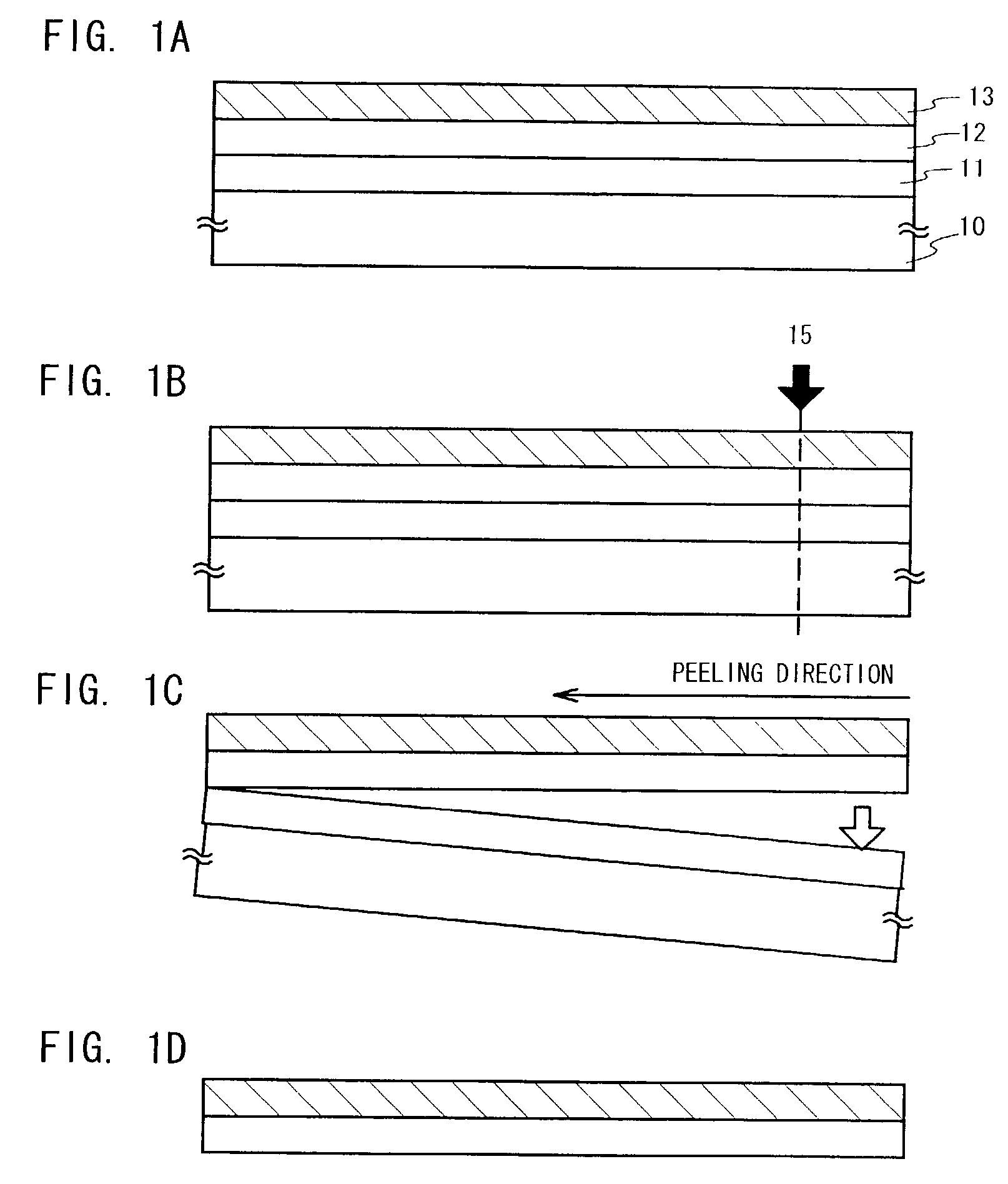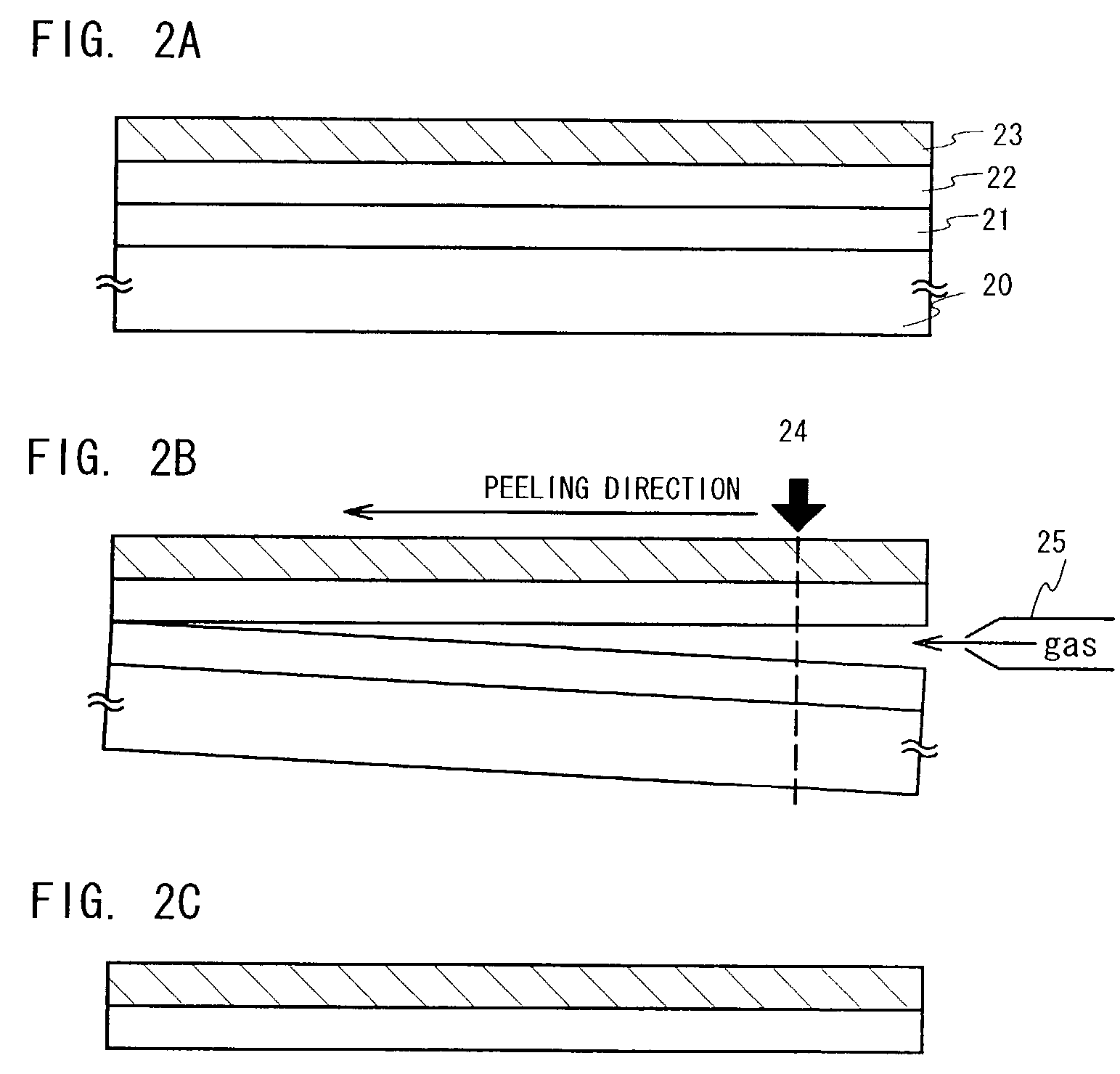Peeling method and method of manufacturing semiconductor device
- Summary
- Abstract
- Description
- Claims
- Application Information
AI Technical Summary
Benefits of technology
Problems solved by technology
Method used
Image
Examples
embodiment mode 1
[Embodiment Mode 1]
[0076]Hereinafter, a typical peeling order according to the present invention will be briefly described using FIGS. 1A to 1D.
[0077]In FIG. 1A, reference numeral 10 denotes a substrate, 11 denotes a first material layer having tensile stress, 12 denotes a second material layer having compression stress, and 13 denotes a layer to be peeled.
[0078]In FIG. 1A, a glass substrate, a quartz substrate, a ceramic substrate, or the like can be used as the substrate 10. In addition, a silicon substrate, a metallic substrate, or a stainless steel substrate may be alternatively used.
[0079]First, as shown in FIG. 1A, the first material layer 11 is formed on the substrate 10. The first material layer 11 may have compression stress or tensile stress immediately after the formation. It is important that the first material layer is formed from a material with which a trouble such as peeling is not caused by heat treatment or laser light irradiation at the formation of the layer to b...
embodiment mode 2
[Embodiment Mode 2]
[0094]In this embodiment mode, an example in which a layer to be peeled is peeled while a gas is blown onto an end surface thereof will be briefly described using FIGS. 2A to 2C.
[0095]In FIG. 2A, reference numeral 20 denotes a substrate, 21 denotes a first material layer having tensile stress, 22 denotes a second material layer having compression stress, and 23 denotes a layer to be peeled. Note that FIG. 2A is the same drawing as FIG. 1A and detailed descriptions are omitted here.
[0096]After the state shown in FIG. 2A is obtained by the same order as Embodiment Mode 1, as shown in FIG. 2B, while laser light 24 is irradiated to a portion, a gas is blown at a high pressure from a nozzle 25 to an interface between the first material layer and the second material layer within an end surface of the substrate, thereby conducting peeling in a direction indicated by an arrow in FIG. 2B.
[0097]Here, a wind pressure is used as physical means. However, it is needless to say ...
embodiment mode 3
[Embodiment Mode 3]
[0105]In this embodiment mode, an example in which a pressure is applied to a layer to be peeled by a diamond pen before peeling to partially reduce contact property will be briefly described using FIGS. 3A to 3D.
[0106]In FIG. 3A, reference numeral 30 denotes a substrate, 31 denotes a first material layer having tensile stress, 32 denotes a second material layer having compression stress, and 33 denotes a layer to be peeled. Note that FIG. 3A is the same drawing as FIG. 1A and detailed descriptions are omitted here.
[0107]After the state shown in FIG. 3A is obtained by the same order as Embodiment Mode 1, as shown in FIG. 3B, external force 35 is applied to a pen 34 to scratch the layer to be peeled, thereby partially reducing the contact property between the first material layer 31 and the second material layer 32. The diamond pen is used here. Preferably, a hard needle is vertically pressed and moved under a load.
[0108]Thus, it is important to prepare a portion w...
PUM
| Property | Measurement | Unit |
|---|---|---|
| Tensile stress | aaaaa | aaaaa |
| Temperature | aaaaa | aaaaa |
| Fraction | aaaaa | aaaaa |
Abstract
Description
Claims
Application Information
 Login to View More
Login to View More - R&D
- Intellectual Property
- Life Sciences
- Materials
- Tech Scout
- Unparalleled Data Quality
- Higher Quality Content
- 60% Fewer Hallucinations
Browse by: Latest US Patents, China's latest patents, Technical Efficacy Thesaurus, Application Domain, Technology Topic, Popular Technical Reports.
© 2025 PatSnap. All rights reserved.Legal|Privacy policy|Modern Slavery Act Transparency Statement|Sitemap|About US| Contact US: help@patsnap.com



